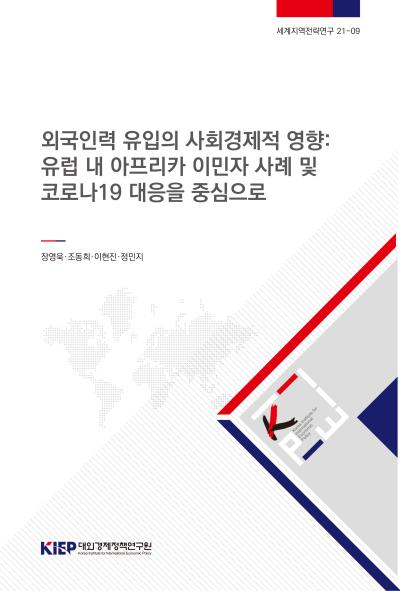Working Papers
PUBLISH
Working Papers
To list

The Socioeconomic Impact of Immigration: Cases of the African Immigrants in Europe andthe Response to Covid-19 Pandemic
Economic cooperation, Labor market
Author Youngook Jang, Dong-Hee Joe, Hyun Jean Lee, and Minji Jeong Series 21-09 Language Korean Date 2021.12.30
This study examines the direct and indirect effects of the influx of foreign workers on the economic, societal and policy response through a case study of African immigrants in Europe and an empirical analysis of the COVID-19 travel restriction policy. A review of European immigration cases is expected to provide policy implications for Korea, where the share of foreign workers is gradually increasing. In addition, this study attempts to understand the impact of the dependence on immigrant workers on domestic policy decisions in the time of national emergency like epidemics.
Specifically, Chapter 2 focuses on the current status of foreign workers in the EU. The foreign workers of the EU are concentrated in member countries with large economies, such as Germany. Currently, the number of non-EU immigrant workers exceeds that of intra-EU immigrant workers, but the latter have been increasing in recent years. The sectoral distribution of foreign workers varies by country. More than one-third of foreign workers in Germany are employed in the industrial sector, whereas in France, foreign employment stands out in the service sector. The distribution of foreign employment in Belgium is not very different from that of native employment. Finland is characterized by a high percentage of foreign employment in agriculture compared to other EU member states.
Chapter 3 deals with the characteristics of African immigrants in Europe. Many of the workers with African origin are either from countries with an existing colonial background or with geographical proximity. In terms of human capital, immigrant workers from Africa account for a large share of the economically active population and those under the age of 15, and are characterized by an overwhelming majority of males. Also, the education and skill levels tend to be lower among the African migrants, who also show a higher rate of unemployment rate than the native-born or other migrants. These characteristics suggest that immigrants from Africa may compete with low-skilled native workers in the receiving country’s labor market.
The human capital characteristics of African migrants lead to socially negative perceptions and discrimination against them in Europe, which is the main focus of Chapter 4. When reviewing the previous literature and statistical evidence, the findings suggest that discrimination against African immigrants in the setting of school, workplace, and media is indeed widespread. According to the European Social Survey, the influx of skilled workers is found to be favored by the citizens of receiving countries, and negative perceptions against African immigrants are not independent of the socioeconomic status of immigrants. In addition, a difference is observed between the perceptions of immigrants from other EU countries and those from Africa.
Chapter 5 attempts to study the impact of the presence of the foreign workers on policy-making, and concludes that the strength of the entry restrictions during the COVID-19 epidemic was affected by share of foreign population. In the countries that are highly dependent on foreign workers, there have been difficulties in supplying labor due to entry restrictions and border closure during the COVID-19 pandemic. The empirical analysis shows that the entry restrictions were passively imposed where the share of immigrant is high. This trend was observed more conspicuously in high-income countries where various policy combinations could be used in addition to entry restrictions. Through these results, it was confirmed that dependence on foreign workers had an impact on policy-making in national emergency situations.
The above-mentioned results of this study can be used for future immigration policy in Korea. The social and economic impact of the influx of immigrants or migrant workers is diverse, and despite its benefits, it can lead to negative consequences such as discrimination, conflict, and polarization. As reviewed in Chapter 1, the foreign population in Korea is rapidly increasing, and given the trend of declining population born in Korea, the incentives to block the influx of foreign populations can be seen as very low. Therefore, it is necessary to develop various policy alternatives in advance to offset the negative impact of the influx of foreign manpower.
Sales Info
| Quantity/Size | 181 |
|---|---|
| Sale Price | 7 $ |
 공공저작물 자유이용허락 표시기준 (공공누리, KOGL) 제4유형
공공저작물 자유이용허락 표시기준 (공공누리, KOGL) 제4유형
대외경제정책연구원의 본 공공저작물은 "공공누리 제4유형 : 출처표시 + 상업적 금지 + 변경금지” 조건에 따라 이용할 수 있습니다. 저작권정책 참조
